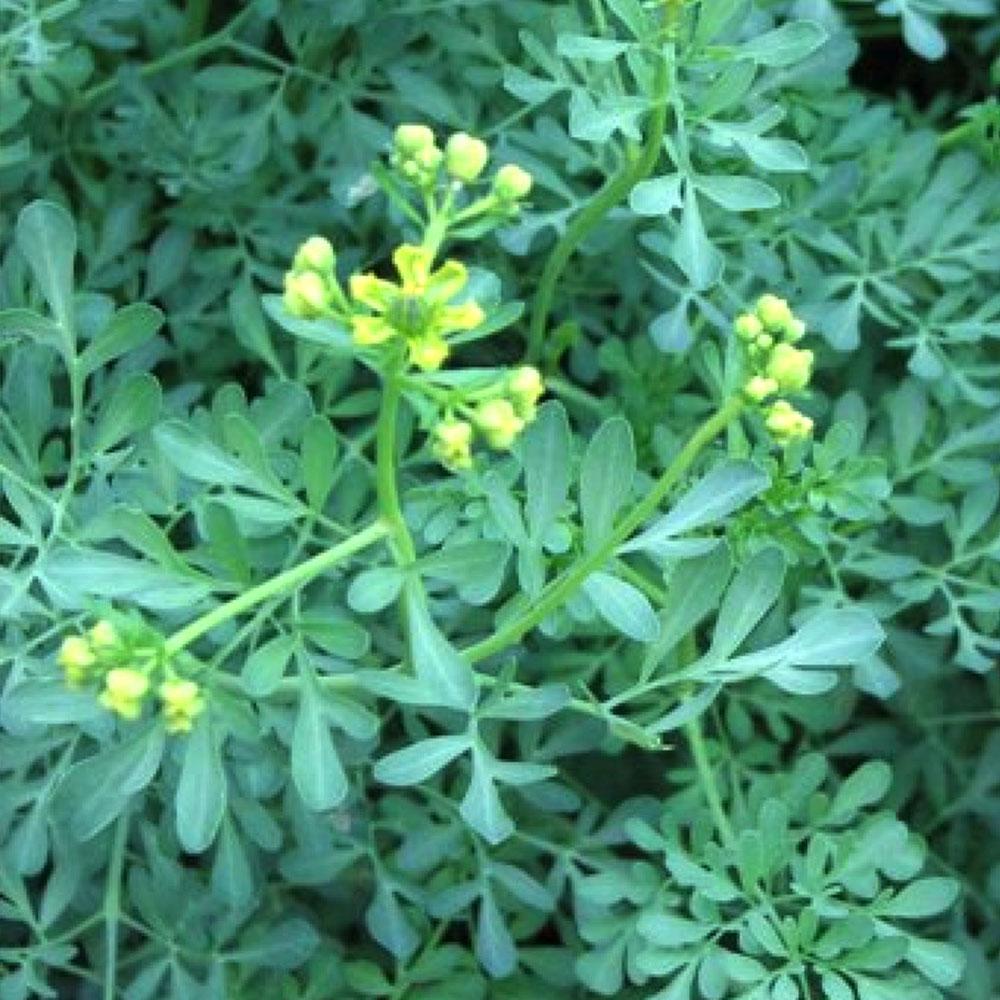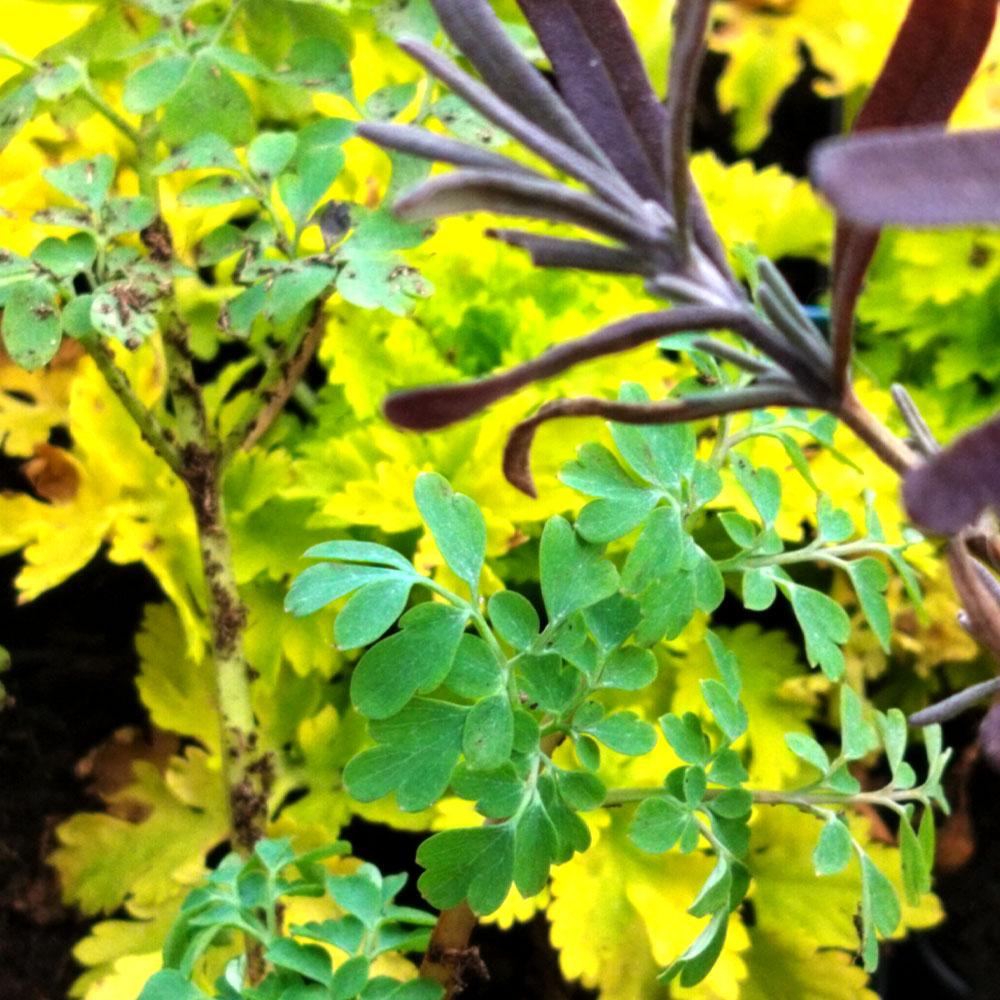No products in the cart.
Ruta graveolens – Rue officinale
Une vivace très parfumée, médicinale au feuillage gris-bleu
Note 0 sur 5
0 avis clients
4,00 € – 10,00 €Plage de prix : 4,00 € à 10,00 €
Tags: aromatique, chaud, comestible, couleur, evergreen, feuillage persistant, gris, médicinales, pepiniere lhoumois, secheresse, vivace en pot
SKU: pda389
Catégorie: Pour les Abeilles et les Papillons, Bien au Balcon, Bouquet, Culinaires, Distillations, Plantes Pérsistantes, Parfumées, Résistantes au Gel, Les Dames Grises, Médicinales, Réensauvagement

Ruta graveolens - Rue officinale
4,00 € – 10,00 €Plage de prix : 4,00 € à 10,00 €
Ruta graveolens est une vivace très parfumée connue pour ses feuilles bleutées et ses propriétés médicinales.
Les feuilles sont oblongues, bleu-vert et possèdent des folioles arrondies. Si vous les frottez doucement, elles dégagent un parfum puissant.
Les fleurs sont petites et jaune pâle, contrastant magnifiquement avec la mer de feuillage gris.
👨🌾CONSEILS DE JARDINAGE👨🌾:
-
- La Rue peut causer de graves phytophotodermatitis (seere la formation de cloques sur la peau) chez certaines personnes, bien que la raison et la fonction de il est actuellement inconnue.
Learn more about Gardening with: Ruta Graveolens
-
-
ENG: Plantura – Rue: Flower, Growing & Uses
-
FR: Ouest France – Comment cultiver la Rue officinale?
-
Les Contes et La Botanique : Ruta Graveolens
Graveolens Fait référence aux feuilles à forte odeur.
🌿 Medicinal Uses of Ruta graveolens
The refined oil of rue (Ruta graveolens) is a traditional emmenagogue, a type of herb that stimulates blood flow in the pelvic area and uterus. It has been historically used to support menstrual health and help address certain hormonal imbalances.
🍹 Culinary & Beverage Uses
In the Mediterranean region, especially Istria, local grappa or ruki is gently flavored with rue, sometimes with a whole branch floating in the bottle. This gives a subtle herbal aroma and reflects traditional Mediterranean culinary uses of Ruta graveolens.
🐾 Animal Repellent
Most cats dislike the strong scent of rue, making it a natural deterrent for gardens or homes. This property is often used in organic pest management or pet-friendly gardening.
✨ Ritual & Cultural Significance
-
Jewish Traditions: During Yom Kippur, Sephardic synagogues sometimes distribute ruda (rue) to congregants, symbolizing protection from malevolent forces and revitalization during fasting.
-
Medieval Flower Bouquets: Rue has been collected with small flowers into nosegays, posies, or tussie-mussies, often wrapped in decorative doilies, a tradition dating back to medieval times.
🐉 Mythology
In folklore, the basilisk, a legendary creature whose breath could wilt plants and crack stones, had no effect on rue, highlighting its mythological reputation as a protective and resilient herb.
🌸 Morphologie Florale
Ruta graveolens, appelée common rue ou garden rue, is a Mediterranean evergreen perennial shrub with aromatic, bluish-green, finely divided leaves.
It produces small, fragrant yellow flowers arranged in cymes or panicles from late spring through summer, adding vibrant color to dry, sunny gardens.
The foliage is slightly pubescent and rough, helping reduce water loss and giving a soft silvery appearance under sunlight.
🌱 Biologie Reproductive
The flowers are bisexual and promote cross-pollination, attracting bees, hoverflies, and other beneficial pollinators.
Seeds are contained in small capsules and disperse easily by wind or gravity, allowing rapid naturalization in dry, Mediterranean-like conditions.
🌍 Ecology & Adaptations : Ruta Graveolens
Native to the Mediterranean region, Ruta graveolens prospère dans rocky, nutrient-poor, well-drained soils, and tolerates coastal winds and salt spray. Key adaptations include:
-
Drought tolerance via pubescent, aromatic foliage
-
Low nutrient requirements, ideal for poor or sandy soils
-
Evergreen leaves that minimize transpiration
-
Rapid regrowth after light pruning, facilitating maintenance and natural propagation
Autres Noms:
Commune de rue
Herbe-de-grâce
🌍 Origine
Balkans
| Poids | 0,5 kg |
|---|---|
| Saison de Plantation | Mars à Mai |
| Couleur des Fleurs | 🟡 Jaune |
| Floraison | Juin, Juillet, Août, Septembre |
| Taille | 0.8m H x 0.8m L |
| Exposition | ☀️ Plein soleil |
| Sol | Sec, Pauvre, Bien Drainant |
| Taille du Pot | 9×9 cm, 2L |
Commentaires
0
Note 0 sur 5
0 avis clients
5
0
4
0
3
0
2
0
1
0
Seuls les utilisateurs connectés les clients qui ont acheté ce produit peuvent laisser un avis.
Autres Produits
Lavandula angustifolia
Une vivace florifère et très aromatique utilisée en cuisine dans de nombreuses cultures.
Une vivace florifère et très aromatique utilisée en cuisine dans de nombreuses cultures.
Note 0 sur 5
Salvia officinalis
Une herbe parfumée utilisée dans de nombreuses cultures pour la cuisine
Une herbe parfumée utilisée dans de nombreuses cultures pour la cuisine
Note 0 sur 5
Euphorbia myrsinites
Connue pour sa forme retombante de feuillage gris argenté et ses fleurs éclatantes.
Connue pour sa forme retombante de feuillage gris argenté et ses fleurs éclatantes.
Note 0 sur 5
Aegopodium podagraria ‘Variegata’
Un couvre-sol populaire, léger, vert et blanc.
Un couvre-sol populaire, léger, vert et blanc.
Note 0 sur 5
Jacobaea maritima
Une plante vivace blanchâtre et velue originaire de la région méditerranéenne.
Une plante vivace blanchâtre et velue originaire de la région méditerranéenne.
Note 0 sur 5
Artemisia Valerie Finnis
Une variation de l'Artemisia semi-persistante et aromatique
Une variation de l'Artemisia semi-persistante et aromatique
Note 0 sur 5
Artemisia alba subsp camphorata
Un buisson aromatique au feuillage gris-vert
Un buisson aromatique au feuillage gris-vert
Note 0 sur 5
Potentilla anserina
Une vivace argentée, soyeuse et dentelée.
Une vivace argentée, soyeuse et dentelée.
Note 0 sur 5
Nepeta x faassenii
Variété plus grande aux feuillage plus résilient
Variété plus grande aux feuillage plus résilient
Note 0 sur 5
Mertensia maritima
Une vivace à feuilles caduques avec charnues, de couleur gris-bleu-vert des feuilles qui, naturellement, se développe sur le vent et la mer balayé les côtes
Une vivace à feuilles caduques avec charnues, de couleur gris-bleu-vert des feuilles qui, naturellement, se développe sur le vent et la mer balayé les côtes
Note 0 sur 5
Artemisia abrotanum
Un buisson gris-vert très parfumé, médicinal et frappant.
Un buisson gris-vert très parfumé, médicinal et frappant.
Note 0 sur 5
Helichrysum italicum
Une vivace au feuillage gris perpétuel et parfumé qui apportera une atmosphère distinctement méditerranéenne.
Une vivace au feuillage gris perpétuel et parfumé qui apportera une atmosphère distinctement méditerranéenne.
Note 0 sur 5
Tanacetum densum subsp amani
Un petit arbuste composé de feuilles douces et finement divisées de couleur gris argenté-blanc.
Un petit arbuste composé de feuilles douces et finement divisées de couleur gris argenté-blanc.
Note 0 sur 5
Cerastium tomentosum var. columnae
Un couvre-sol étalé gris-vert des montagnes.
Un couvre-sol étalé gris-vert des montagnes.
Note 0 sur 5
Sedum spectabile Septemberglut
A species of flowering plant in the stonecrop family – drought tolerant, with vibrant pink flowers and a spectacularly long flowering period.
A species of flowering plant in the stonecrop family – drought tolerant, with vibrant pink flowers and a spectacularly long flowering period.
Note 0 sur 5
Stachys byzantina
Feuilles soyeuses blanc-gris et grandes fleurs saisissantes.
Feuilles soyeuses blanc-gris et grandes fleurs saisissantes.
Note 0 sur 5
Salvia sclarea – Sauge sclarée
Une plante vivace duveteuse principalement cultivée pour son huile essentielle.
Une plante vivace duveteuse principalement cultivée pour son huile essentielle.
Note 0 sur 5
Helichryse orientale
Une plante vivace avec un feuillage doux, gris cendré, et des fleurs jaunes en forme de boutons.
Une plante vivace avec un feuillage doux, gris cendré, et des fleurs jaunes en forme de boutons.
Note 0 sur 5
Vu récemment
Tradescantia Green Hill
Feuilles petites, vert foncé et violettes.
Feuilles petites, vert foncé et violettes.
Note 0 sur 5
Koeleria glauca Blue Sprite
Une graminée ornementale naine au feuillage bleuté
Une graminée ornementale naine au feuillage bleuté
Note 0 sur 5
Erigeron glaucus
Une plante à fleurs avec de grandes fleurs blanc-rosées.
Une plante à fleurs avec de grandes fleurs blanc-rosées.
Note 0 sur 5
Aster novi-belgii ‘Henri Picot’
De grands nuages de fleurs bleu vif.
De grands nuages de fleurs bleu vif.
Note 0 sur 5
Tradescantia sillamontana Variegata
Une plante d’intérieur duveteuse, jaune vif, résistante à la sécheresse.
Une plante d’intérieur duveteuse, jaune vif, résistante à la sécheresse.
Note 0 sur 5














































Il n'y a pas encore de reviews.